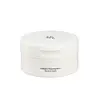What's inside
What's inside
 Key Ingredients
Key Ingredients

 Benefits
Benefits

 Concerns
Concerns

 Ingredients Side-by-side
Ingredients Side-by-side

Cetyl Ethylhexanoate
EmollientCaprylic/Capric Triglyceride
MaskingPEG-20 Glyceryl Triisostearate
EmollientSynthetic Wax
AbrasivePEG-10 Isostearate
EmulsifyingLactobacillus/Soybean Ferment Extract
Skin ConditioningHippophae Rhamnoides Oil
EmollientOryza Sativa Bran Oil
EmollientOryza Sativa Seed Water
AntimicrobialAvena Sativa Meal Extract
SoothingCoix Lacryma-Jobi Ma-Yuen Seed Extract
Skin ConditioningOryza Sativa Extract
AbsorbentWater
Skin ConditioningSorbitan Sesquioleate
EmulsifyingGlycerin
HumectantPropanediol
SolventButylene Glycol
Humectant1,2-Hexanediol
Skin ConditioningCaprylyl Glycol
EmollientEthylhexylglycerin
Skin ConditioningCetyl Ethylhexanoate, Caprylic/Capric Triglyceride, PEG-20 Glyceryl Triisostearate, Synthetic Wax, PEG-10 Isostearate, Lactobacillus/Soybean Ferment Extract, Hippophae Rhamnoides Oil, Oryza Sativa Bran Oil, Oryza Sativa Seed Water, Avena Sativa Meal Extract, Coix Lacryma-Jobi Ma-Yuen Seed Extract, Oryza Sativa Extract, Water, Sorbitan Sesquioleate, Glycerin, Propanediol, Butylene Glycol, 1,2-Hexanediol, Caprylyl Glycol, Ethylhexylglycerin
Ethylhexyl Palmitate
EmollientPEG-20 Glyceryl Triisostearate
EmollientIsododecane
EmollientHydrogenated Poly(C6-14 Olefin)
EmollientSynthetic Wax
AbrasivePEG-10 Isostearate
EmulsifyingSilica Dimethyl Silylate
EmollientParfum
MaskingOlea Europaea Fruit Oil
MaskingCentella Asiatica Leaf Extract
Skin ConditioningGlyceryl Stearate
EmollientWater
Skin ConditioningSimmondsia Chinensis Seed Oil
EmollientPolyglyceryl-3 Polyricinoleate
EmulsifyingGardenia Florida Fruit Extract
Skin ConditioningCarthamus Tinctorius Flower Extract
Skin ConditioningButylene Glycol
HumectantCoptis Japonica Extract
AntimicrobialGlycerin
Humectant1,2-Hexanediol
Skin ConditioningDipropylene Glycol
HumectantPolyglyceryl-10 Oleate
Skin ConditioningCentella Asiatica Root Extract
Skin ConditioningCentella Asiatica Extract
CleansingPentylene Glycol
Skin ConditioningMadecassoside
AntioxidantCapryloyl Salicylic Acid
Exfoliating4-Terpineol
MaskingPrunus Amygdalus Dulcis Oil
Skin ConditioningPropanediol
SolventAsiatic Acid
Skin ConditioningMadecassic Acid
Skin ConditioningAsiaticoside
AntioxidantChamomilla Recutita Flower Oil
MaskingIndigofera Tinctoria Extract
MaskingCynanchum Atratum Extract
Skin ConditioningHemerocallis Fulva Flower Extract
Skin ConditioningMyosotis Sylvatica Flower/Leaf/Stem Extract
Skin ConditioningHydroxycinnamic Acid
Skin ConditioningRutin
AntioxidantEthylhexyl Palmitate, PEG-20 Glyceryl Triisostearate, Isododecane, Hydrogenated Poly(C6-14 Olefin), Synthetic Wax, PEG-10 Isostearate, Silica Dimethyl Silylate, Parfum, Olea Europaea Fruit Oil, Centella Asiatica Leaf Extract, Glyceryl Stearate, Water, Simmondsia Chinensis Seed Oil, Polyglyceryl-3 Polyricinoleate, Gardenia Florida Fruit Extract, Carthamus Tinctorius Flower Extract, Butylene Glycol, Coptis Japonica Extract, Glycerin, 1,2-Hexanediol, Dipropylene Glycol, Polyglyceryl-10 Oleate, Centella Asiatica Root Extract, Centella Asiatica Extract, Pentylene Glycol, Madecassoside, Capryloyl Salicylic Acid, 4-Terpineol, Prunus Amygdalus Dulcis Oil, Propanediol, Asiatic Acid, Madecassic Acid, Asiaticoside, Chamomilla Recutita Flower Oil, Indigofera Tinctoria Extract, Cynanchum Atratum Extract, Hemerocallis Fulva Flower Extract, Myosotis Sylvatica Flower/Leaf/Stem Extract, Hydroxycinnamic Acid, Rutin
 Reviews
Reviews

Ingredients Explained
These ingredients are found in both products.
Ingredients higher up in an ingredient list are typically present in a larger amount.
1,2-Hexanediol is a synthetic liquid and another multi-functional powerhouse.
It is a:
- Humectant, drawing moisture into the skin
- Emollient, helping to soften skin
- Solvent, dispersing and stabilizing formulas
- Preservative booster, enhancing the antimicrobial activity of other preservatives
Butylene Glycol (or BG) is used within cosmetic products for a few different reasons:
Overall, Butylene Glycol is a safe and well-rounded ingredient that works well with other ingredients.
Though this ingredient works well with most skin types, some people with sensitive skin may experience a reaction such as allergic rashes, closed comedones, or itchiness.
Learn more about Butylene GlycolGlycerin is already naturally found in your skin. It helps moisturize and protect your skin.
A study from 2016 found glycerin to be more effective as a humectant than AHAs and hyaluronic acid.
As a humectant, it helps the skin stay hydrated by pulling moisture to your skin. The low molecular weight of glycerin allows it to pull moisture into the deeper layers of your skin.
Hydrated skin improves your skin barrier; Your skin barrier helps protect against irritants and bacteria.
Glycerin has also been found to have antimicrobial and antiviral properties. Due to these properties, glycerin is often used in wound and burn treatments.
In cosmetics, glycerin is usually derived from plants such as soybean or palm. However, it can also be sourced from animals, such as tallow or animal fat.
This ingredient is organic, colorless, odorless, and non-toxic.
Glycerin is the name for this ingredient in American English. British English uses Glycerol/Glycerine.
Learn more about GlycerinPEG-10 Isostearate isn't fungal acne safe.
Peg-20 Glyceryl Triisostearate comes from Isostearic Acid and glycerin.
It is an emollient, emulsifier, and gentle cleanser. As an emollient, it helps trap moisture to keep skin soft and hydrated. Emulsifiers help prevent ingredients from separating.
This ingredient is common in oil-based products. This is because it helps oil-ingredients be easily washed away without leaving a residue.
Peg-20 Glyceryl Triisostearate may not be fungal-acne safe.
Learn more about PEG-20 Glyceryl TriisostearatePropanediol is an all-star ingredient. It softens, hydrates, and smooths the skin.
It’s often used to:
Propanediol is not likely to cause sensitivity and considered safe to use. It is derived from corn or petroleum with a clear color and no scent.
Learn more about PropanediolSynthetic Wax is created from fossil fuels such as natural gas. It is used to enhance texture, adjust pH, and as an occlusive.
It may also be used as an abrasive ingredient to exfoliate the skin.
Synthetic Wax may not be fungal acne safe.
Learn more about Synthetic WaxWater. It's the most common cosmetic ingredient of all. You'll usually see it at the top of ingredient lists, meaning that it makes up the largest part of the product.
So why is it so popular? Water most often acts as a solvent - this means that it helps dissolve other ingredients into the formulation.
You'll also recognize water as that liquid we all need to stay alive. If you see this, drink a glass of water. Stay hydrated!
Learn more about Water